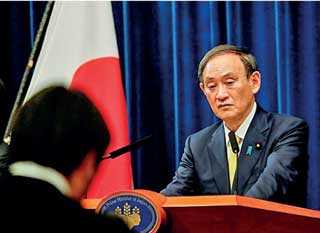Thursday May 02, 2024
Thursday May 02, 2024
Wednesday, 9 December 2020 00:00 - - {{hitsCtrl.values.hits}}
 |
| Japanese Prime Minister Yoshihide Suga speaks during a news conference in Tokyo
|
TOKYO (Reuters): Japan announced a fresh $ 708 billion economic stimulus package on Tuesday to speed up the recovery from the country’s deep coronavirus-driven slump, while targeting investment in
new growth areas such as green and digital innovation.
The new package will include about 40 trillion yen ($ 384.54 billion) in direct fiscal spending and initiatives targeted at reducing carbon emissions and boosting adoption of digital technology, Prime Minister Yoshihide Suga said in a meeting with ruling party executives.
Policymakers globally have unleashed a wall of monetary and fiscal stimulus to prevent a deep and prolonged recession as the coronavirus closed international borders and sent millions out of work. In the United States, a $ 908 billion coronavirus aid plan is currently under debate in Congress.
In Japan, the pandemic has forced the government to put its fiscal reform agenda on the backburner, despite holding the industrial world’s heaviest public debt burden, which is twice the size of its gross domestic product.
“We have compiled the new measures to maintain employment, sustain business and restore the economy and open a way to achieve new growth in green and digital areas, so as to protect people’s lives and livelihoods,” Suga said at the meeting.
Suga’s cabinet is set to endorse the stimulus package later on Tuesday, which would bring the combined value of coronavirus-related stimulus to about $ 3 trillion.
The government will compile a third extra budget for the current fiscal year worth around 20.1 trillion yen to fund the fresh economic stimulus, a government source told Reuters on Tuesday.
Two previous packages this year worth a combined $ 2.2 trillion focused on dealing with the immediate strain on households and business from the pandemic.
Japan’s economy, the world’s third-largest, rebounded in July-September from its worst postwar contraction in the second quarter, though many analysts expect a third wave of COVID-19 infections to keep any recovery modest.